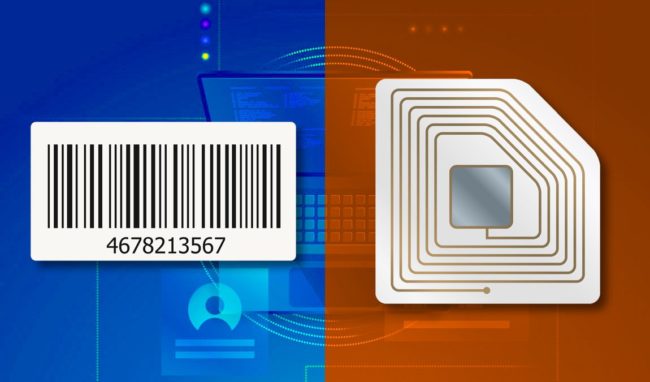Using RFID for Inventory Management: Pros and Cons


In the ever-evolving world of inventory management, there’s a constant focus on improving efficiency. Companies of all sizes are regularly evaluating their current capabilities and finding ways to squeeze as much efficiency as possible out of their existing infrastructure while preparing to adopt new technologies that can take their performance to new levels.
Now, more than ever, it is important for operations management to do their due diligence of thorough research and a proper ROI analysis to fully understand the impact that any change could have on their entire operation.
One emerging technology that has received a lot of attention with the potential to revolutionize the inventory management industry is radio-frequency identification (RFID). This article will explore the current state of RFID tag usage—including pros and cons–some insights on their utility versus the leading solution for asset tracking and inventory management (barcode labels) and a look at RFID inventory management systems.

The use of RFID for inventory management requires a scanner that uses radio waves to communicate with an RFID tag. The tag itself contains a microchip that allows the reader to read data and also write data to the tag for real-time updating in place. Each tag is wrapped in a material like plastic or paper for protection and can be affixed to a variety of surfaces for tracking.
When it comes to using RFID for inventory management, there are two different types of tags you can use.
Using RFID for inventory management offers several benefits, such as reduced labor costs and faster scanning. Here’s a look at how RFID tags can be a benefit in the inventory management process.
While there are some benefits of using RFID for inventory management, the technology also comes with several disadvantages that hinder usability and introduce other concerns, such as security. Here’s a look at the distinct disadvantages of using RFID tags for inventory management.
While the use of RFID in inventory management offers some compelling and tangible benefits, there is a great deal of work to be done to streamline these systems. Much of the challenge involves scaling this solution in a cost-effective way while updating infrastructure enough to be able to capitalize on its greatest benefits.

RFID can be useful for some applications, but for most companies looking for an accurate, user-friendly, and cost-effective solution for inventory management, barcode labels are a proven and trusted solution. Some barcode labels, such as Camcode’s Metalphoto® inventory tags, are durable enough to withstand harsh environments in both indoor and outdoor applications and offer excellent resistance to chemicals, solvents, and abrasion.
Compared to RFID tags, barcodes are just as accurate if not better, and they can be affixed to any surface material without impacting accuracy.
In contrast, materials like metal can interfere with an RFID tag’s ability to transmit data, and liquid can hinder an RFID tag’s signal. While it’s possible to use RFID tags on metal surfaces or items, it requires the use of a special type of tag with an RFID block to prevent interference, adding to the overall cost.
Understanding the total cost of an RFID system implementation can be a complex undertaking as there are many expenses to consider. The largest initial cost is often the equipment, which can include readers, cabling and antennas.
Passive RFID reader systems can run about $1000 per reader and cost as much as $3000 per reader, when you factor in the cabling and other expenses such as power over Ethernet (POE) that are usually required to operate them. In the case of active reader systems, the equipment costs can be about 10 times cheaper than a passive system because they tend to be less sophisticated and complex.
Additional up-front costs can include installation, asset management software, facility modifications which can vary widely for each unique situation.
Ongoing costs for an RFID system include tags, licensing fees, and maintenance.
One of the benefits of operating a passive RFID system over the long term is the low cost of tags. Passive RFID tags only cost about 5 to 15 U.S. cents per chip, though there can be a higher cost for tags with special housings such as those that protect against interference from metal objects.
Active RFID tags generally cost between $5 and $15 each, about 100 times as much as the passive tags, because they require a local power source and more involved housing design.
The main difference between an active and passive RFID inventory system is the way in which the inventory tags are powered during operation, but the basic workflow in a warehouse is the same for both configurations.
Before a shipment is sent to the warehouse it will have had an RFID tag, or chip, attached to individual items or an entire pallet. This RFID tag stores important information about the item.
When the shipment arrives at the destination, each RFID tag will transmit its information to readers installed within the warehouse. These readers will have been placed in strategic locations within the receiving and storage areas to pick up the best possible signal.
The data is transmitted via electromagnetic waves and is relayed from the readers to a central warehouse management system. From there, information can be modified and sent back to the RFID tags for later recall at any time.
This gives warehouse operators the ability to perform tasks such as real-time asset counts and advanced inventory transactions.
Using RFID for inventory management has been shown to improve inventory accuracy by up to 13% compared to traditional inventory tracking methods and manual inventory checks in some situations. Particularly in the retail industry, where maintaining inventory accuracy is an ongoing challenge, there are some benefits to implementing a more automated system.
In a warehouse environment, the implementation costs may outweigh the benefits in some cases. It can be beneficial in situations where a very high inventory accuracy rate is required, but there is always a balance between hardware and labor costs that should be considered.
For companies looking to adopt an inventory tracking solution, it’s important to conduct a thorough analysis of the differences between established technologies such as barcode labels and tags designed for inventory control and newer solutions like RFID to ensure that you will achieve a desirable ROI for your investment.
For most companies, barcode labels are smart and practical choices for inventory management.
RFID tags attached to products can track inventory through the supply chain. This provides real-time data on item location, shipment status, and stock levels. One example is Walmart: the retailer uses RFID to manage inventory at over 5,000 stores globally.
The average cost for passive UHF RFID tags is around 10-15 cents per tag when purchased in bulk orders of thousands. More advanced tags with sensors can range from 50 cents to $50 depending on capabilities.
Key benefits of RFID in warehouses include:
Radio Frequency Identification (RFID) tags are an ideal asset tracking system in certain applications. However, RFID does have some inherent shortcoRadio Frequency Identification (RFID) tags are an ideal asset tracking system in certain applications. However, RFID does have some inherent shortcomings in functionality, durability and security. Click below to see the pros and cons of RFID, as well some alternatives that may be better suited to your particular tracking project.mings in functionality, durability and security. Click below to see the pros and cons of RFID, as well some alternatives that may be better suited to your particular tracking project.

Our sales engineers are experts in automatic asset tracking, tagging and identification,a nd can answer all your questions. Get in touch now.
Lets Talk ›Enter your information and get a free checklist of the top questions to answer and tips to plan a successful asset tagging project for any asset management or tracking system implementation.